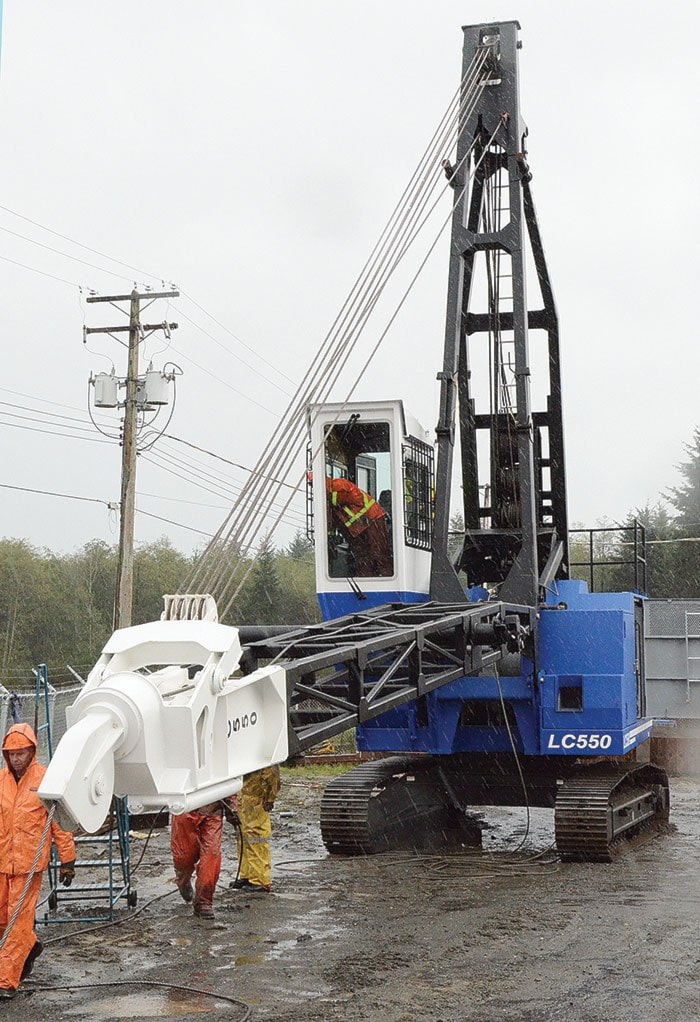After over five years of research and development, a revolutionary $1.3-million “Made-in-Campbell River” piece of forestry equipment has been shipped to its buyer.
“The whole world is watching this,” said George Lambert, President of T-Mar Industries, who developed the new grapple yarder. “New Zealand knows about this. The U.S. is watching this. The whole world is paying attention to this project, so it’s a really great thing for Campbell River. It’s really exciting.”
According to Lambert, old-growth forests and second-growth forests present different challenges to foresters, and yet there was until now only one type of yarder to do both types of jobs.
Second-growth forests, he said, are more unified, since all the trees in an area will be the same age, which has some advantages, but some disadvantages, as well.
“The equipment traditionally used is designed for old-growth,” he said. “They’re bigger machines, and they weren’t quite as efficient (at harvesting smaller-growth logs). We wanted to build a machine that would handle smaller log sizes more quickly, efficiently, and be safer.”
What they came up with is the Log Champ 550, which Lambert said he thinks will likely be the new benchmark set in the industry.
“If people want to be in this business, they’re going to have to go down this path,” he said.
That’s because it’s not just that the machine is just better at dealing with smaller and more uniform logs that is making the world sit up and take notice.
“We also wanted a machine that could be transported much easier,” Lambert said. “There’s an overall shipping length that you’re restricted to on the highway, so we had to make the machine as compact as we could lengthwise and still get everything in it we needed, and at the same time, we had to make a machine that had inherently good balance.
“The bigger machines obviously have transportation challenges around their size and weight. You have to take them apart to move them on the highway (because of the transportation regulations). That’s time and expense that isn’t spent logging. Essentially the cost of doing business goes up.
“One of our targets with this machine was that the machine, when assembled, with lines on it, would be legal to transport on the highway in one piece.”
Another focus of the design crew was to make the machine more efficient. With the increasing cost of fuel motivating efficiencies in the industry, they wanted to reduce the amount of fuel we were using per cubic meter of wood moved. Part of that was putting all the parts on a smaller frame, and part was removing “parasitic load,” or wasteful energy use.
“We also wanted to make a new, modern user control system,” Lambert said, listing off the new features of the yarder. “We’ve got a new workforce that needs to be trained that is more computer literate. We wanted to make something they’d be a bit more used to and was more intuitive for them.”
For example, there are aspects of the machine that could be used remotely.
“There may be some situations where the fella who’s out there hook tending may want to take over the control of the machine for some reason,” Lambert explained. “Suppose he sees a situation that’s unsafe, where wood is moving and people could get injured,” he said. In a situation like that, the person on the ground might have a remote override to stop the machine, for example.
Another function of the updated computerized controls is the ability to implement a “repeat system” where the operator would record a function, and then have the machine repeat it as many times as necessary to complete a job.
“It’s not technology that’s not known, or anything, it’s just never been applied in this way.”
Lambert feels that projects like these are important for the community as a whole – that it’s not just T-Mar that should be celebrating this achievement.
“I think it’s important for B.C. to continue to be a world leader in the manufacture and design of this type of equipment. We have been for a long time, and we kind of lost that a little bit in the past few years. We have the intellectual power here to do it, so we were determined to kind of help wrestle that back,” he said.
“I think it’s very important for Campbell River specifically in the sense that for us to have a strong manufacturing base like this here in our community is an important thing. It’s something we can build on.”
The first Log Champ 550 shipped on Oct. 22, but Lambert said he expects they can make three or four per year for the next 15 or 20 years as the project moves forward and the design continues to evolve, making it a long-term project that will help support to the economic future of the region.
